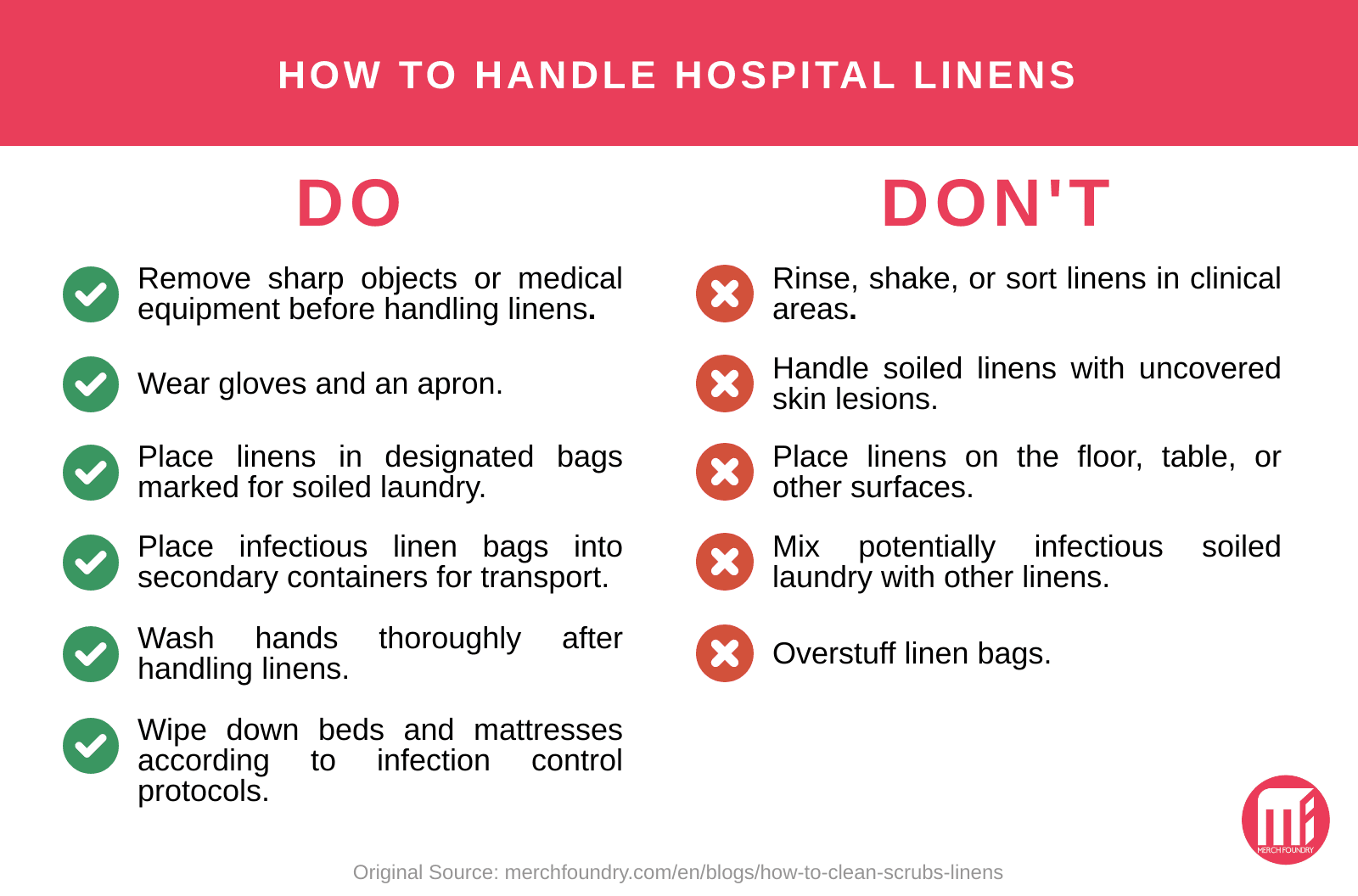Laundry Requirements for Healthcare Uniforms and Linens
Washing healthcare uniforms and linens is no simple task.
You need controlled, consistent systems that thoroughly clean the textiles. You need the systems to be working every day without fail. You also need procedures that will protect anybody coming into contact with the fabric — healthcare workers, patients, delivery staff, launderers, and so on.
To make things trickier, healthcare fabrics often each have their own care instructions. Some can be washed in hot water and bleach, while others can only be washed cold.
Fail to do any of these and those uniforms and linens could pose significant risks to healthcare workers and patients...or shorten the lifespans of the garments.
Here’s what we’ll cover:
- How to safely handle soiled or infectious hospital linens
- Washing practices that will effectively remove potential pathogens
- How to remove spore-forming organisms
How to Handle Healthcare Linens
Hospital linens can contain bodily substances like blood, skin, feces, urine, vomit, and other tissues and fluids. These carry potentially infectious substances. That’s why medical personnel should be careful when handling these linens in the ward, during transport, or when processing at the laundry facilities.
Here’s a list of what to do and what NOT to do, based on MOH guidelines:

You don’t have to wear a mask, but you should make sure not to shake or sort the linens in clinical areas. Doing so could disturb pathogenic organisms on the linens and make them airborne.
Make sure to wear proper PPE (gloves and an apron will do) while you’re putting the soiled linens into designated laundry bags. These bags should be clearly marked for soiled, heat labile, and potentially contaminated soiled linens based on where the laundry came from.
When transporting potentially contaminated linens, make sure the bags are impervious to fluids and won’t leak. Put the bags into a secondary container before transporting them to the decontamination facilities.
If you’re using laundry chutes, make sure these are properly designed with negative air pressure. This prevents airborne microorganisms from spreading throughout the facility.
Once transported to the laundry facilities, staff should wear gloves and aprons before handling linens.
Make sure your workflow physically separates dirty linens from clean ones. Wash, package, store, and transport clean linens in a manner that prevents re-contamination.
How to Wash Linens, Medical Clothes, and Hospital Uniforms
Like hospital linens, medical clothes and hospital uniforms can carry potentially infectious substances.
In most cases, healthcare facilities that require their staff to wear uniforms must also provide professional laundering services so that medical personnel do not carry contaminants out into the public. This is not required if medical staff aren’t working in high-risk zones, however.
Washing Protocol for Linens
If the linens are heat stable, wash them at:
- Over 65˚C for at least 10 minutes. This is a 14-minute cycle time on low loading, or 18-minute cycle time on high loading.
- OR preferably 71˚C for at least 3 minutes. This is a 7-minute cycle time on low loading, or 11 minutes on high loading.
Washing the linens at these temperatures will eliminate most contaminants except for spore-forming organisms. To eliminate spore-forming organisms, use chemical disinfection with sodium hypochlorite and achieve a free chlorine concentration of over 180 ppm in the second rinse.
If you’re working with heat labile materials, use chemical disinfection at a low temperature (e.g. sodium hypochlorite at >150 ppm free chlorine).
Drying and Transport of Clean Linens
Once washed and dried, clean linens should be moved to a separate work area away from soiled linens. Package the clean linens prior to transport to ensure that they aren’t contaminated by dust and dirt while on the way back to the healthcare facility. There are a few ways to do this:
- Putting clean linen in a hamper with a previously unused liner, then closing this
- Putting clean linen in a clean cart, then covering this securely
- Wrapping the clean linen in plastic (or other suitable material) and sealing the bundles
Washing Protocol for Medical Clothes and Hospital Uniforms
As long as they’re not contaminated with bodily substances, medical scrubs and uniforms are treated the same as street clothes: washing the clothes at home is enough to remove any microbial contamination. That said, healthcare facilities that require the use of uniforms should make sure that the medical clothes are properly washed. This means either engaging professional laundering services themselves or educating staff on proper washing guidelines for infection control.
This goes doubly for professionals who still wear lab coats: in one study, students perceived that white coats were clean as long as they weren’t visibly dirtied by bodily fluids, even if they hadn’t washed the lab coats for several weeks.
Caring for your linens from disinfecting, to washing and drying to linen management is no easy feat.
Need help? Partner with us today to uphold the highest standards of cleanliness and linen care. We are dedicated to support your business with the best technology solutions and laundry management services. We support locations across Singapore, including Changi and Tuas areas. Contact us or view our catalogue here.